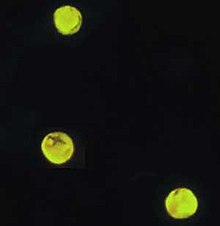Auramine-Rhodamine stain
The auramine-rhodamine staining is a staining method for examining bacteria with acid-proof cell walls such as mycobacteria by fluorescence microscopy . This particularly detects Mycobacterium tuberculosis , the causative agent of tuberculosis . It belongs to the cold dyeing classes and is significantly faster than the Ziehl-Neelsen dyeing . The staining solution consists of auramine O and rhodamine B .
Individual evidence
- ↑ PKH Hagemann: Fluorescence microscopic examinations of virus and other microbes. In: Zentralblatt für Bakteriologie, Parasitenkunde, Infectious Diseases and Hygiene. Department 1 originals. Volume 140, 1937, p. 184.
- ↑ PKH Hagemann: fluorescence staining of tubercle bacteria with aurarnine. In: Munich Medical Weekly. Volume 85, 1938, pp. 1066-1068.
- ^ H. Silver, AC Sonnenwirth, N. Alex: Modifications in the fluorescence microscopy technique as applied to identification of acid-fast bacilli in tissue and bacteriological material . In: Journal of Clinical Pathology . tape 19 , no. 6 , November 1966, p. 583-588 , doi : 10.1136 / jcp.19.6.583 , PMID 4162852 , PMC 473386 (free full text).
- ↑ GJ Ryan, DR Hoff, ER Driver, MI Voskuil, M. Gonzalez-Juarrero, RJ Basaraba, DC Crick, JS Spencer, AJ Lenaerts: Multiple M. tuberculosis Phenotypes in Mouse and Guinea Pig Lung Tissue Revealed by a Dual-Staining Approach . In: PLoS ONE . tape 5 , no. 6 , 2010, p. e11108 , doi : 10.1371 / journal.pone.0011108 , PMID 20559431 , PMC 2885421 (free full text).
